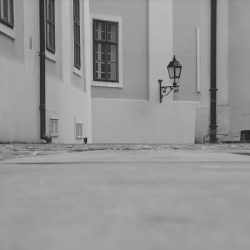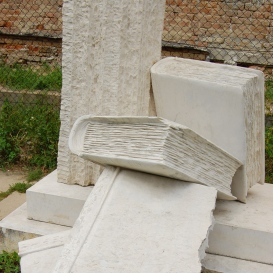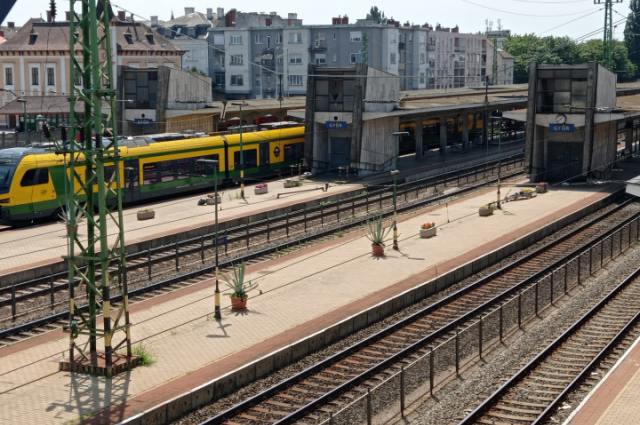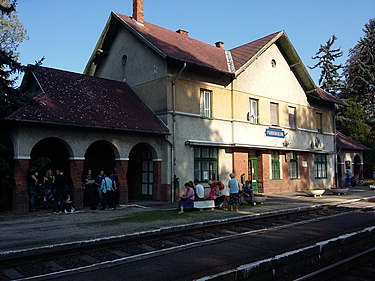
( Day 3) Győr-Pannonhalma

In Győr, five churches of five religions are located in close proximity to each other in a unique location on a single street. After leaving from the city and following the Pannonhalma cycle path in the direction of Lake Balaton and Veszprém, we arrive at an open, flat area where, according to the locals, there is always a headwind. After 10 kilometres, the landscape changes, we leave the flat Kisalföld behind and enter the Sokoró hills. As we get closer and closer to the building complex of the Pannonhalma Abbey on the top of the hill, its impressive shape gradually emerges with each kilometre we complete. Entering the city, after the first small climb, we stop at the " At everyone's crossroads", where St. Martin welcomes us. After that, either we muster up the strength to cycle up to the main entrance of the abbey, which already has a real sporting value, or we can leave our bikes at the base of the hill and discover all the values and the panorama that St. Martin's Hill offers on foot.
More details about the route
Leaving in the morning, from the Rába double bridge, Győr's other river, River Rába, shows her face; her changeable, sometimes fast, sometimes slow, moody character. The river flows into the Danube 200 metres west of here, and they continue their journey together to the Danube Delta, the Black Sea. Turning towards Kossuth Street, the Old Evangelical Church, built without a tower, hides almost unnoticed in a closed courtyard.
The Synagogue, which is located a few steps away from here, serving now as a museum and concert hall, is much more striking with its characteristic hemispherical domes and rosette windows. The tall tower of the neighbouring Reformed Church and the St. John Parish Church built a little lower on the other side of the road, can also be seen from afar. The line is closed by the Serbian Orthodox Church, which today is the place of the religious life of the local Greek Catholic community - its beautiful wall covered with icons - on the iconostasis – as well as its carved pews make it special.
With the exception of the Synagogue, the above-mentioned churches can be visited during services and during the Five Churches guided tours.
Győr
Spiritual provision
 |
The Roman and Greek Catholic (former Serbian Orthodox), the Lutheran, the Reformed Church and the Synagogue stand peacefully next to each other.
In Martin's time, the emperor began to persecute the Priscillians. The essence of the movement was the living of evangelical poverty, the rejection of carnal desires (and sometimes marriage), "pure" Christianity. This group was mostly driven by good intentions. However, they also strongly criticized the secularizing, increasingly comfortable and wealthy church leaders and the custodians of political power. The founder of the movement, Priszcillianus was executed by Emperor Maximus in 385 AD.
On one occasion, Martin lay down in front of the gate of Avitianus Comes’ palace for the whole night to beg for the lives of the prisoners destined for death. The execution planned for the next day was not carried out by the shocked Comes, the prisoners were saved. Martin interceded for persecuted Christian groups, considered heretics.
Can I be a man of peace? Are you a person who understands what you disagree with? Who speaks the truth, but does not force anyone to accept it? |
One street - five religions, five churches. |
Moving away from the Moson-Danube, leaving the city towards the east, you can already see St. Martin's hill with the Pannonhalma Archabbey in the distance, which majestically accompanies our journey. When you reach the city, the plain is replaced by steep hills, it is recommended to leave your bike near the path at the bottom of the hill leading to the abbey, and continue your journey on foot.
Everyone's way of the cross is next to the "Little Church" in Pannonhalma. At the beginning of the road, the statue of St. Martin welcomes us. Passing by the columns, we can find representations of each station of the cross. Leaving the Way of the Cross, we head up the hill, accompanied by the shining dome of St. Martin's Basilica. Looking back and forth during our journey, green wooded groves and fields fill the landscape.
Crossing the entrance of the Main Abbey on the cobbled road, we are greeted by many sights - the St. Martin's Basilica, the Cloister or the library with 400,000 volumes, which preserves relics related to Hungary, are definitely worth a visit.
Pannonhalma
Spiritual provision
|
|
Saint Stephen, although he was one of the most powerful rulers in Europe - in 1030 he destroyed the armies of Conrad, the German emperor at Győr - he never started wars of conquest. He had churches built, founded monasteries and schools, dioceses.
Christianity fertilized the history of humanity in an amazing way. Christians created the first free hospital open to all in history (in Caesarea, Cappadocia in the 4th century AD) and the first free school. Not rich kings or emperors, but simple, poor Christian monks. The clear appearance of the concept of human dignity, which is the main basis of our entire Western legal system, the social network, and the democratic state order, also has Biblical roots, as well as does the start of the huge scientific and technical development, to which Europe and the world owe so much.
Christianity is a fertilizing, life-giving source. When we try to preserve values, we don't stick to stones, we don't stick to petrified traditions, but we try to stay close to the Source and draw from it. The personalist philosopher Martin Buber said that a culture lived as long as it was connected to the Animating Secret that once had created it. Europe has a future as long as it can draw from this life-giving source.
Do I know this source, its enormous history-shaping power?Do I live near the source, am I in touch with the living water? What can I do to cleanse the well of life so that I can draw more from it? |
The first Hungarian school. |
Leaving the Abbey, following the local trail, we reach the Chapel of Our Lady. From the 20-metre high lookout point located in the park forest surrounding the Abbey, the waves of the Sokorói hills can be seen in front of us. We can also enjoy the beauty of the landscape below us from the high path extending above the canopy of trees. The path has the shape of one of the oldest Christian symbols, the fish.
The quality delicacies cannot be left out here either. Excellent wines, liqueurs, snacks bearing the abbey's trademark, and teas made from herbs and lavender based on abbey recipes can be consumed and purchased. On a winery tour, you can also taste local wines in the unique abbey winery, and even around St. Martin's Day, you can get the wine that bears his name; St. Martinus.
In the evening, we can have a rest by taking advantage of the local accommodation options, or we can return to Győr by bicycle or train.
- Duration: 1 hour(s)
- Length: 20,5 km
- Difficulty: Easy
| Area: | Velo Martini |
| Level difference: | 10 m |
| Típus: | Cycling routes |
Szolgáltatás Stop point
Stop point - Pannonhalma
PannonhalmaSights of Pannonhalma: Church of the Assumption, Way of the Cross, Holocaust Memorial and Synagogue, Papal Memorial Cross
MoreStop point - Pannonhalma - Church of the Blessed Virgin Mary
Pannonhalma - Gyümölcsoltó Boldogasszony -templom
Church of the Assumption of the Blessed Virgin Mary
The foundations of the church date from the 12th-13th centuries. It was...
Stop point - Pannonhalma - Everyone's Crossroads
Pannonhalma - Mindenki keresztútjaThe Way of the Cross, inaugurated in autumn 2014, is located in the park next to the parish church, behind the statue of St...
MoreStop point -Pannonhalma - Holocaust Memorial and Synagogue
Pannonhalma - Holocaust emlékmű és zsinagóga
Holocaust Memorial and Synagogue
The memorial was erected in 2004 by the Karzat Cultural Centre Foundation in memory of the...
Stop point - Pannonhalma Archabbey
Pannonhalma -FőapátságFounded in 996 and still, in continuous operation, the Benedictine monastery of Pannonhalma is one of Hungary's most outstanding...
More
























